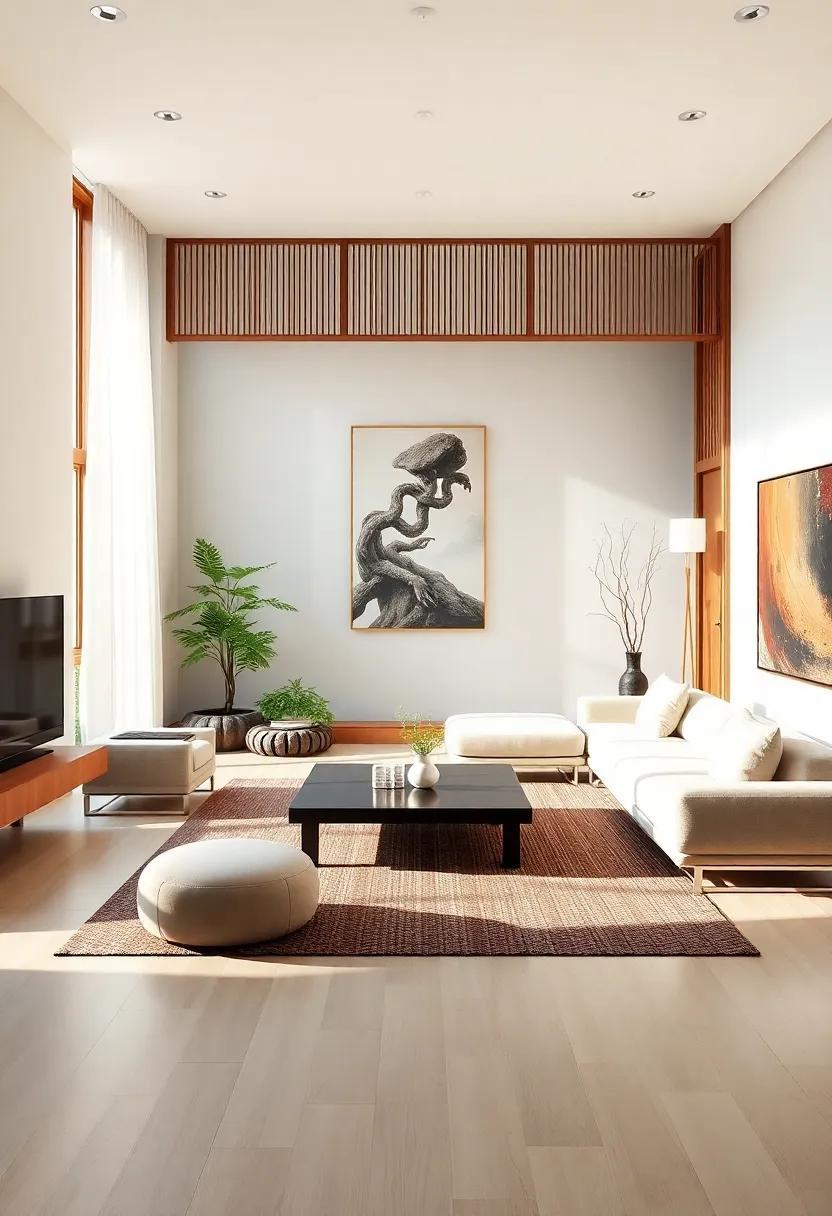In a world that often feels chaotic adn overwhelming, the pursuit of tranquility has never been more essential. As individuals increasingly seek solace within their own homes, the serene aesthetics of Japanese garden design offer a peaceful refuge from the hustle and bustle of daily life. Integrating elements of this timeless tradition into your living room can transform the space into a harmonious retreat where nature’s beauty and simplicity take center stage. From the gentle curves of gravel patterns to the calming presence of stone lanterns and lush greenery, each component plays a role in cultivating a atmosphere of serenity. Join us as we explore the art of blending these exquisite elements into your living room design, creating a sanctuary that nurtures both the mind and spirit.
Serenity Through Nature: The Essence of Japanese Gardens in Modern Interiors
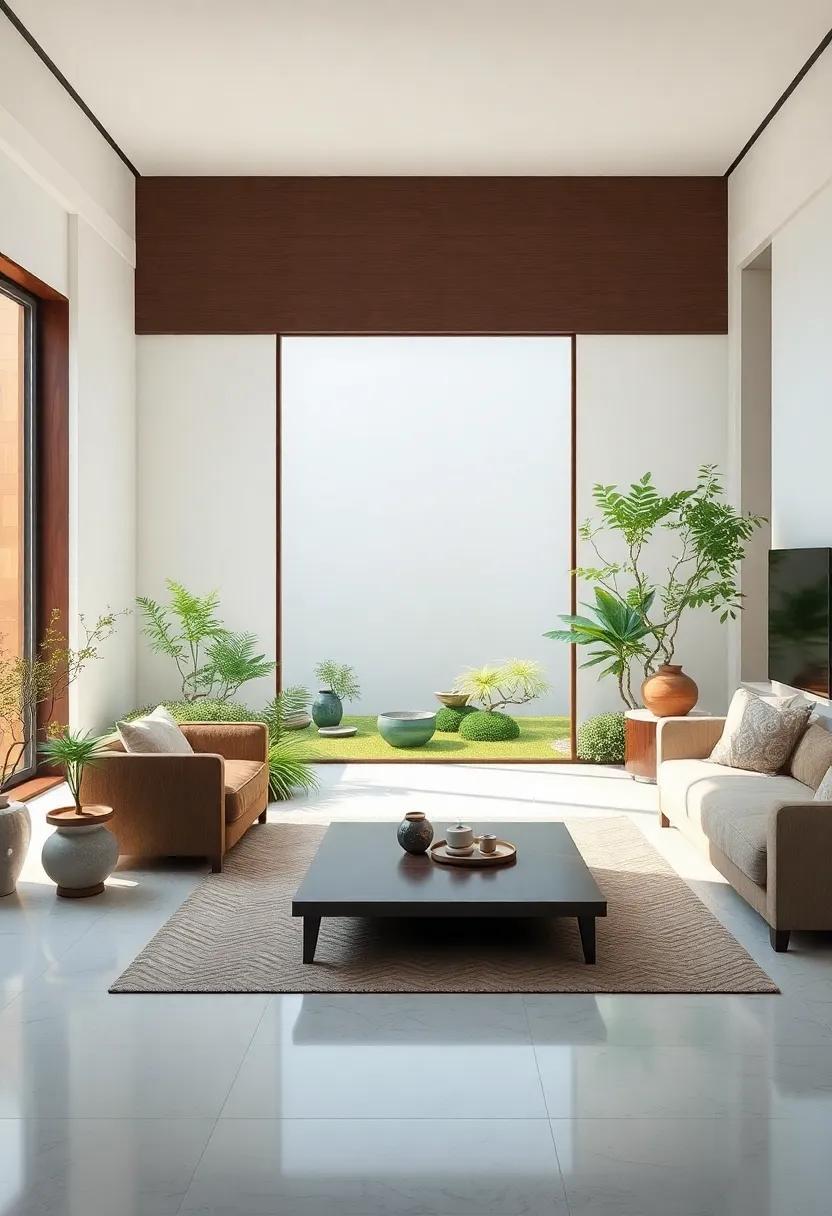
Incorporating elements of customary Japanese gardens into your living room design offers a pathway to tranquility and balance. These serene landscapes emphasize harmony with nature, often featuring asymmetry and natural materials that invite a sense of peace. To achieve this in your own space, consider integrating the following elements:
- Natural Textures: Use wood, stone, and bamboo materials to mimic the feel of a garden.
- Soft Colors: Choose a muted color palette that reflects the earth tones commonly found in Japanese gardens.
- zen Accents: Include decorative stones, simple plant arrangements, or a sand garden to accentuate calmness.
Creating a harmonious flow within your living room can also be achieved through the strategic use of focal points. These can range from beautifully arranged potted bonsai trees to floor-length shoji screens that filter light while adding an authentic touch. A small table showcasing a miniature zen garden can serve as both a captivating sight and a functional centerpiece. Hear’s a simple idea for a table setup to inspire your design:
| Element | Description |
|---|---|
| Mini Zen Garden | add sand, small stones, and a rake for a tranquil vibe. |
| Bonsai Tree | A living piece of art that embodies nature within your space. |
| Fluid Lines | Choose curved furniture or accessories to mirror nature’s shapes. |
By thoughtfully incorporating these elements, your living room can transform into a serene retreat that celebrates the essence of Japanese gardens, providing a perfect balance of beauty and relaxation.
For more inspiration on incorporating natural elements into your home, visit Houzz.
Harmony in Space: Creating Balance with Minimal Decor and open Layouts
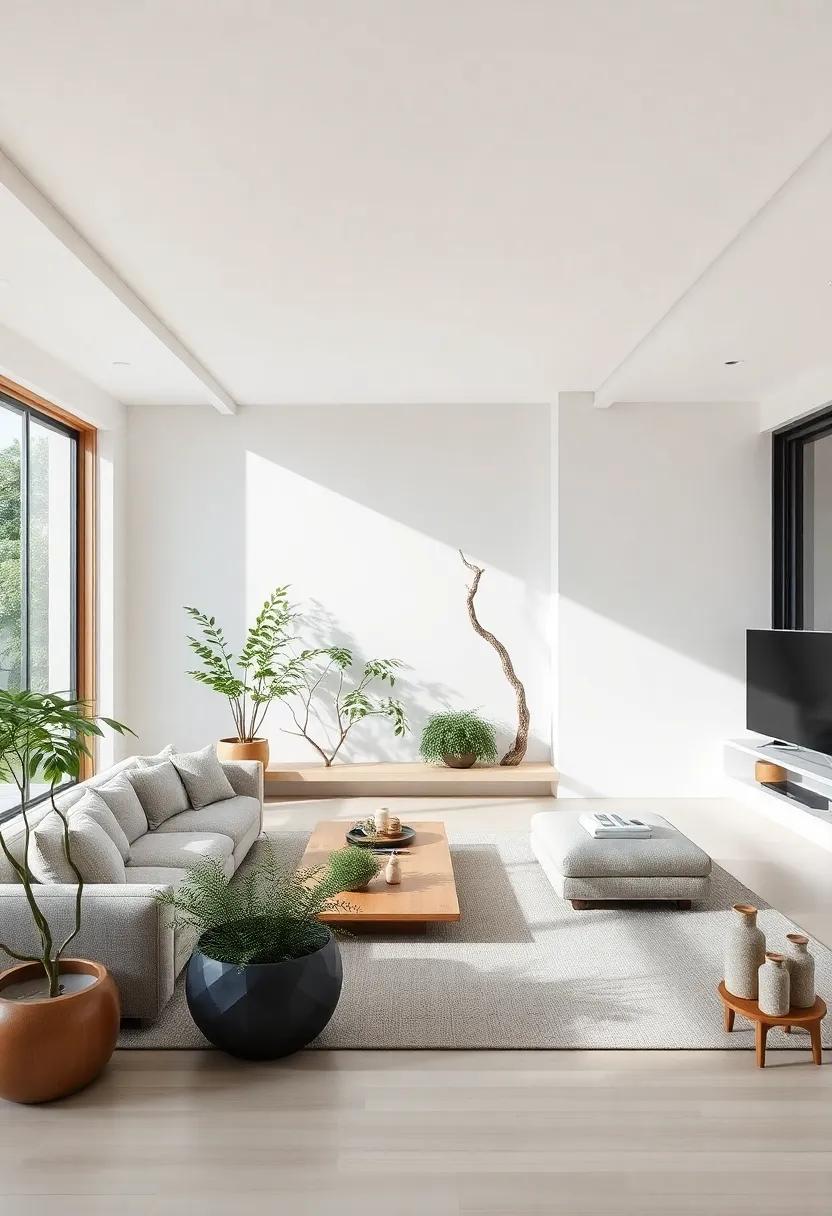
In cultivating a sanctuary within your living room, embracing minimal decor and open layouts paves the way for serenity. By selecting a few key elements inspired by Japanese gardens, you can create a harmonious surroundings that radiates tranquility. Consider incorporating elements such as:
- Natural wood furniture
- Soft, ambient lighting
- Live plants for a touch of greenery
- Textured fabrics in neutral tones
Such choices not only enhance the aesthetic but also promote a sense of balance, seamlessly blending interior and exterior spaces.
Furthermore, maximizing open layouts allows for fluid movement and connectivity throughout the room. Think of using dividers that maintain clarity, such as shoji screens or open shelving, to subtly delineate areas without sacrificing openness. You might also explore simple arrangements that focus on functionality without clutter, which can include a low table surrounded by floor cushions or a minimalist seating arrangement. This mindful approach invites a peaceful atmosphere reminiscent of tranquil Japanese gardens, allowing you to recharge and find balance in everyday life.For further inspiration, visit Japanese Gardens.
Zen Minimalism: Selecting Essential Furniture to Reflect Simplicity
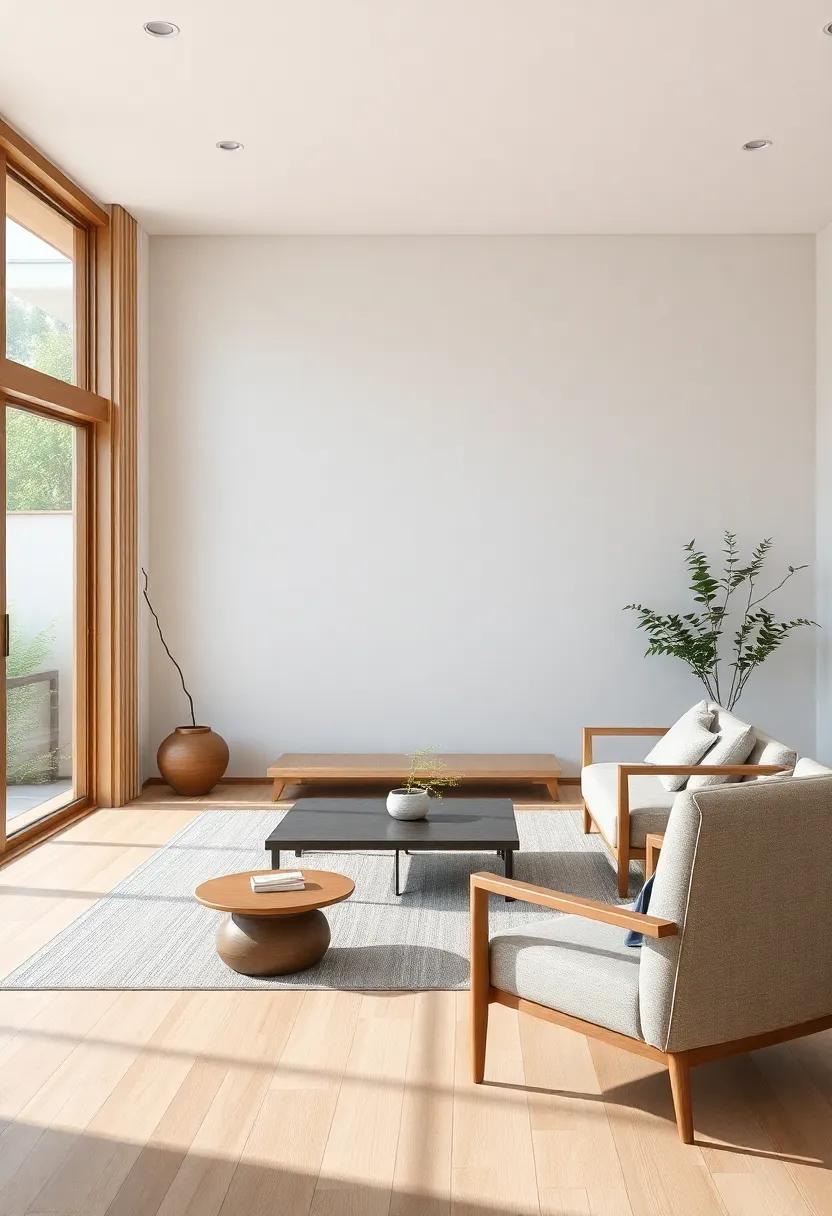
Creating a serene living space requires careful consideration of the furniture that populates it. Adopting a minimalistic approach means choosing pieces that not only serve a purpose but also evoke a sense of tranquility. Start by selecting low-profile sofas with clean lines, perhaps in muted tones such as soft beige or calming grey to provide a gentle contrast to the vibrant elements of nature. pair these with simple wooden coffee tables crafted from natural materials, reflecting the organic textures found in a Japanese garden.Integrating tatami mats or natural fiber rugs can also ground the space, enhancing the feeling of being connected to nature.
In addition to larger furniture items, consider adding essential decorative elements that align with the theme of simplicity. Utilize a small collection of ceramic vases or minimalist sculptures that mimic the shapes of garden stones or bamboo. Plants play a vital role in conveying the essence of a japanese garden, so choose low-maintenance varieties like succulents or bonsai trees that add a lively touch without overwhelming the space. For a cohesive look, ensure all pieces share a muted color palette and an organic feel. these intentional selections embody the ideology of less is more, allowing you to cultivate a peaceful environment that invokes the serenity of a garden.
natural Materials: Embracing Wood and Stone for an Authentic Feel
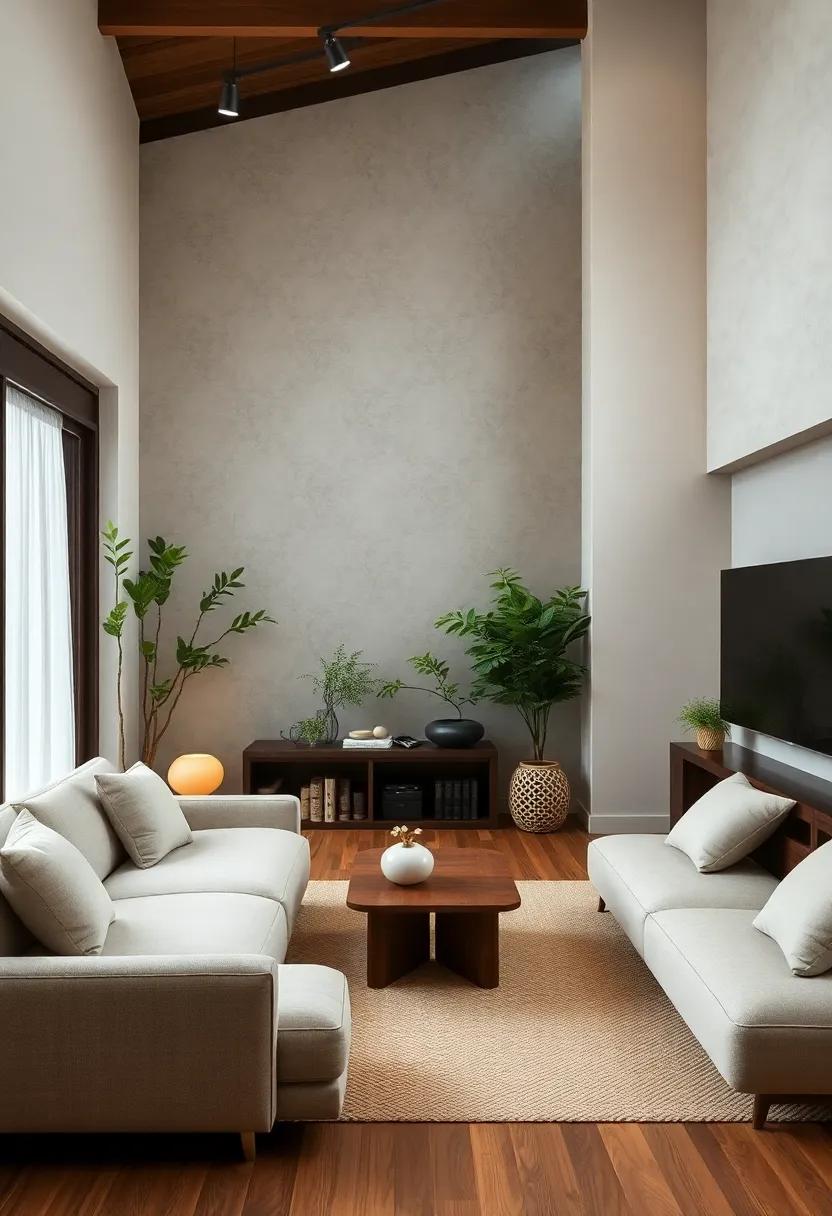
Incorporating natural materials like wood and stone into your living room not only fosters a sense of authenticity but also creates a grounding aesthetic reminiscent of serene Japanese gardens. Wood, with its warm tones and unique grain patterns, can be utilized in furnishings—from low-profile coffee tables to elegant bookshelves. The choice of textures is crucial; opting for reclaimed wood can bring character and a story to your space, while polished finishes can emphasize a modern touch. When coupled with stone elements, such as slate tiles or a minimalist stone fireplace, the combination enhances the overall tranquility, echoing the simplicity found in traditional Japanese landscapes.
To further curate this organic feel, consider integrating elements like bamboo accents, succulent planters, or even a stone water feature. These components not only improve the aesthetics but also invite nature’s essence into your home. Incorporating these materials can be as simple as selecting a few key pieces or transforming an entire area. A furniture layout that allows for natural light to flow and highlights these materials can promote relaxation and connection to the outdoors. Explore options like https://www.houzz.com for inspiration on blending earthy tones and textures that encapsulate the calm of a Japanese garden within your living space.
Soft Color Palettes: Choosing Soothing Shades That Enhance Tranquility
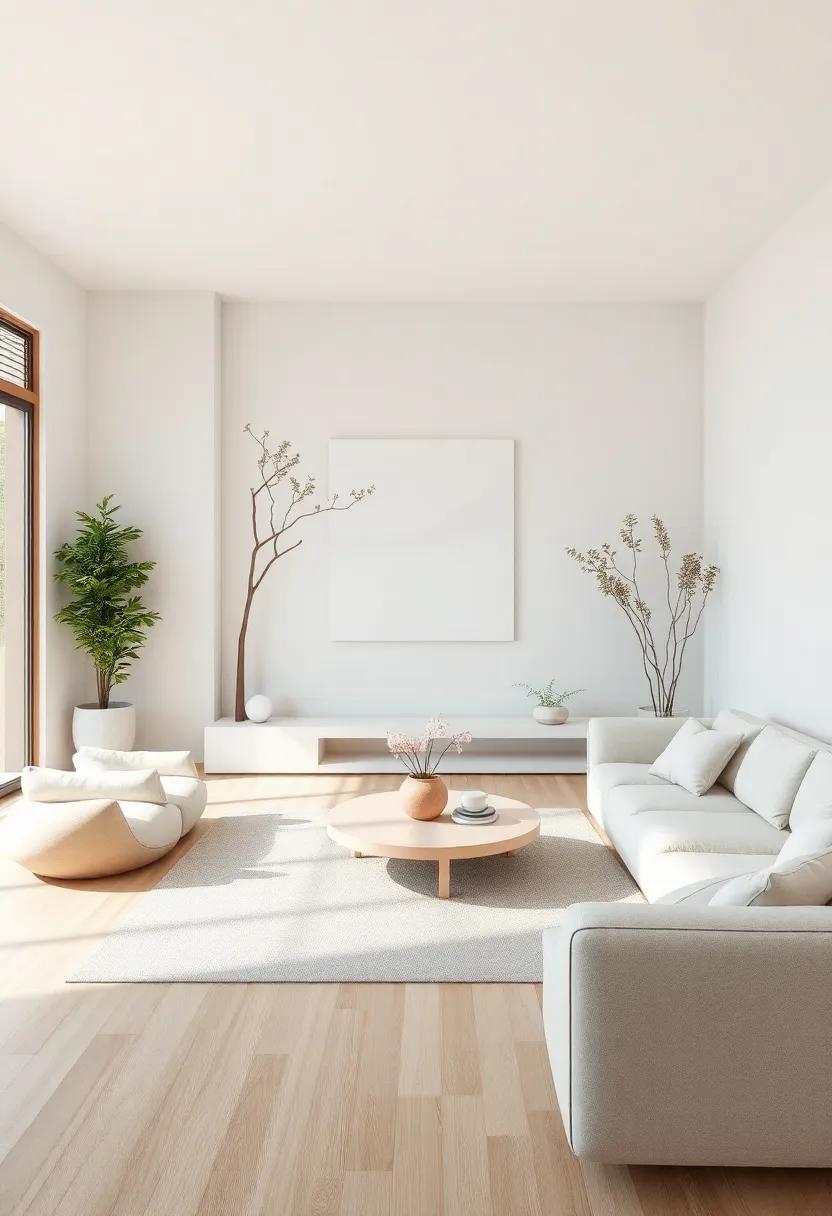
When it comes to creating a serene atmosphere reminiscent of a traditional Japanese garden,the choice of color palette plays a critical role. Opt for soft and muted shades that evoke the quiet beauty of nature, such as pale greens, gentle blues, and soft earth tones.These colors not only enhance tranquility but also allow for seamless integration with natural materials typically found in Japanese aesthetics like wood and stone. Incorporating these shades into your decor can bring a sense of calm and balance to your living room, creating a peaceful retreat within your home.
To effectively implement a soothing color scheme, consider these harmonious combinations:
- Pale Sage green – Pairs well with cream accents.
- Soft Sky Blue - Complements warm beige and light grey.
- Muted Terracotta – Works beautifully with natural wood tones.
- Light Lavender – Balances with soft white for a refreshing look.
By carefully selecting these colors, you can create a design that not only resonates with the principles of a Japanese garden but also promotes a sense of zen and relaxation. For further inspiration on color choices and serene design ideas, visit Dwell.
Indoor Plants: infusing Life and Freshness with Japanese Flora
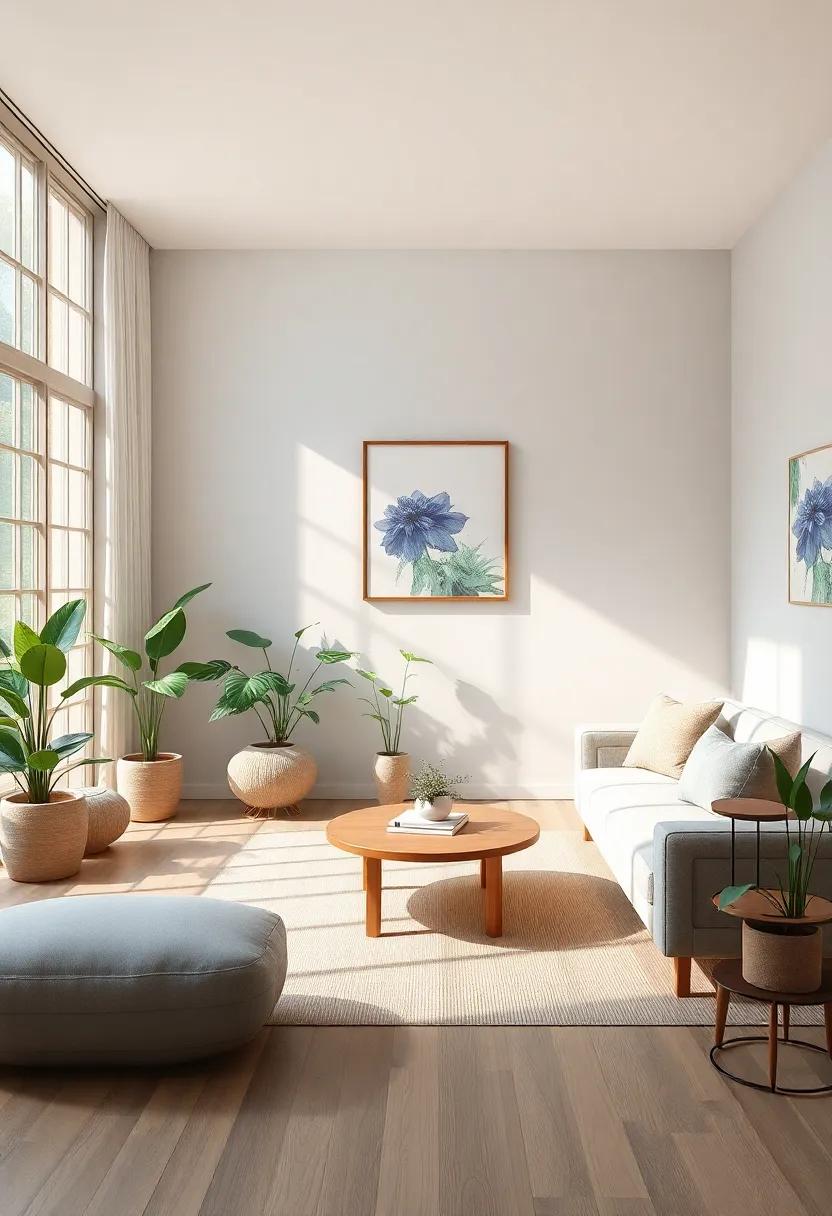
Incorporating Japanese flora into your living room not only elevates the aesthetic but also invites a sense of tranquility. The soft elegance of Ficus lyrata (Fiddle Leaf fig) or the soothing presence of Zamioculcas zamiifolia (ZZ Plant) can create a serene atmosphere reminiscent of a traditional Japanese garden. These plants thrive indoors, requiring minimal care while providing maximum impact. To enhance your living space, consider these elements:
- Variety of textures: Mix smooth leaves of the ZZ Plant with the bold, patterned foliage of a Snake Plant.
- Simple arrangements: Use clean lines and asymmetrical groupings for an authentic Japanese aesthetic.
- Natural materials: Pair plants with bamboo planters or ceramic pots to maintain a harmonious balance.
To enhance the effects of your indoor plants,focus on their placement. Positioning your flora near natural light sources not only promotes growth but also emphasizes their vibrant presence. Alongside plants, consider integrating decorative elements such as stones or gravel, evoking the spirit of a Zen garden. A small table below could offer an effective overview of ideal indoor plants and their light requirements:
| Plant Name | Light Preference | Notes |
|---|---|---|
| Fiddle Leaf Fig | Bright, indirect light | Large leaves create a focal point |
| ZZ plant | Low to bright light | Very low maintenance |
| Peace Lily | Low to medium light | Blooms with white flowers |
With these thoughtful elements in place, you can cultivate an oasis of calm right in your home. Explore more about the art of Japanese gardening at Japanese Gardening.
Artful Arrangements: Designing a Peaceful Focal Point with Accessories
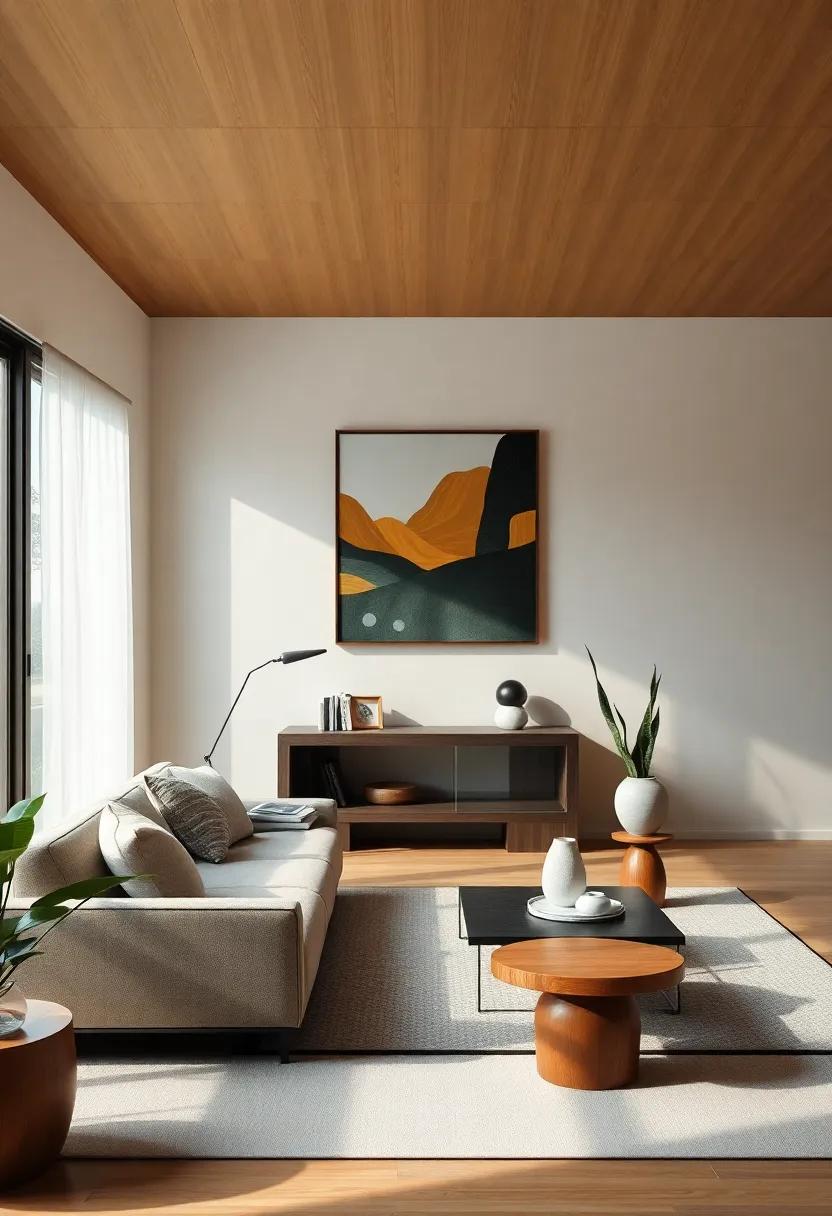
Creating a serene focal point in your living room can be effortlessly achieved by thoughtfully arranging accessories inspired by Japanese garden aesthetics. Begin by selecting a central feature, such as a small bonsai tree or a carefully designed stone lantern, which embody the tranquility of nature. Surround this centerpiece with calming colors and natural materials—think soft, neutral tones and textures like bamboo or smooth stones. Complementary items such as minimalist ceramics or soft textiles can enhance the peace while adding layers of interest. Incorporating these elements creates an inviting atmosphere that encourages relaxation and mindfulness.
To further enrich this calming design,consider incorporating subtle lighting and natural elements. Soft, warm lighting can be mimicked with lantern-style fixtures or candles that create gentle illumination, evoking the tranquil ambiance of a Japanese evening garden. Additionally, utilize a selection of carefully arranged pebbles, succulents, and faux moss to emulate zen simplicity in a way that brings the outside in. Creating a visual harmony with these accessories not only makes your living room a sanctuary but also immerses you in a serene environment that promotes peace and well-being. For more inspiration on Japanese garden elements, visit japanesegardening.org.
Water Elements: Integrating Subtle Water Features for Calming Sounds
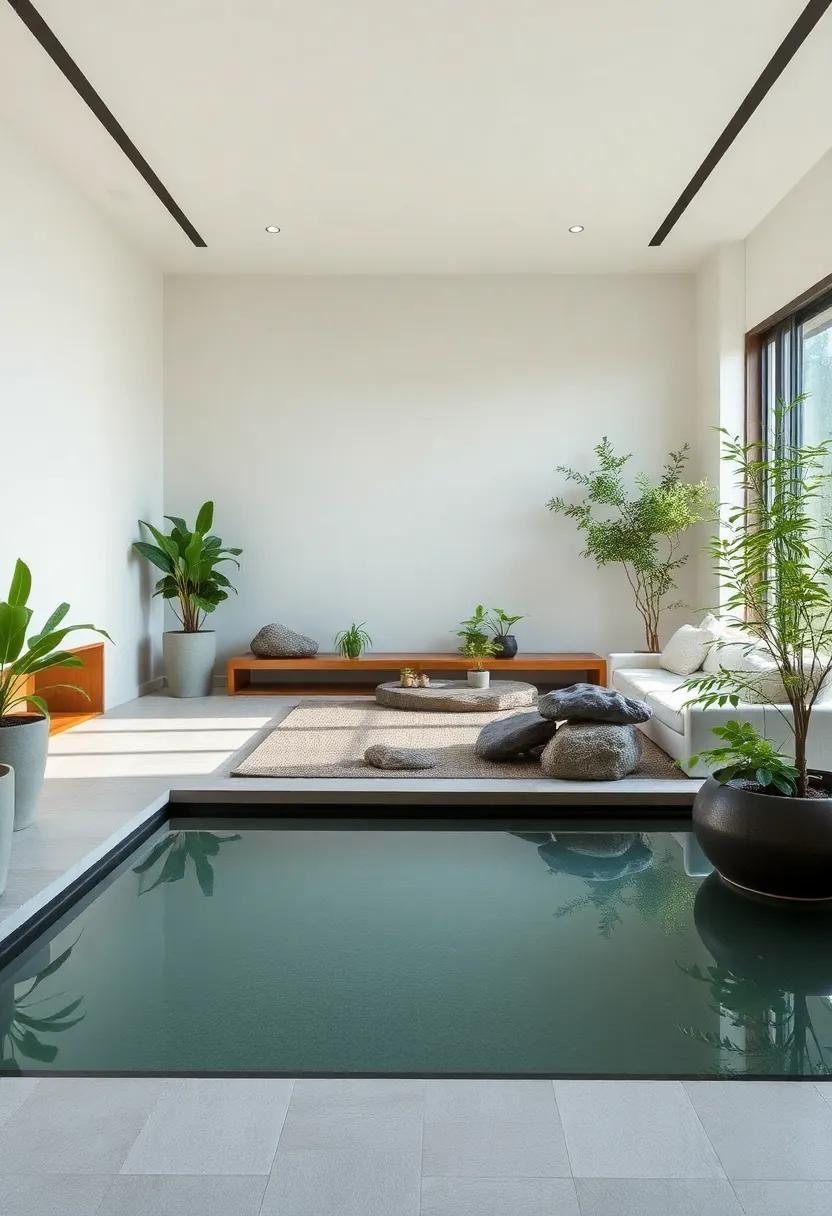
Integrating subtle water features into your living space can evoke tranquility and relaxation, reminiscent of traditional Japanese gardens. These elements may include small tabletop fountains or aquariums, strategically placed to create a soothing ambiance with gentle sounds of flowing water. Consider the following options to enhance your living room:
- Desktop Fountains: ideal for small spaces, these can be located on shelves or coffee tables.
- Wall-Mounted Waterfalls: A stunning focal point, they provide a dynamic visual while adding soothing sound to the room.
- Accessories: Incorporate decorative bowls filled with water or bamboo arrangements that can hold pebbles, mimicking a miniature landscape.
To further enrich the experience of tranquility,consider the use of lighting to enhance the reflective quality of water. Soft, diffused illumination can create a serene atmosphere, especially during the evening.Incorporate LED lights around water features to highlight their beauty and amplify the calming sounds they produce. Here’s a simple table to help you visualize how to incorporate these elements:
| Water Feature | Benefits | Placement |
|---|---|---|
| Tabletop Fountain | Calming sounds and minimal space usage | Living room desk or side table |
| Wall Waterfall | Striking visual with soothing sounds | Main wall in the living room |
| Water Bowl | Promotes relaxation and aesthetic appeal | Corner nook or center of a coffee table |
By thoughtfully integrating these water elements, your living room can transform into a peaceful sanctuary, allowing you to escape the daily hustle. For further inspiration on creating tranquility at home, explore The Spruce.
Paper Screens: Utilizing Shoji for Light and Space Division
Incorporating shoji screens into your living room is a wonderful way to merge functionality with aesthetics. These traditional Japanese sliding doors, crafted from lightweight wood frames and translucent paper, effortlessly create a serene atmosphere while allowing light to filter through. By placing these screens strategically, you can achieve a harmonious balance between openness and division, sectioning off areas for relaxation or meditation without entirely isolating them from the rest of the space. The playful dance of light and shadow creates a dynamic environment that evolves throughout the day, enhancing the overall serenity of your living area.
Not only do shoji screens promote tranquility, but they also contribute to the Zen-like appeal of your home by adding textural interest and an organic touch. To maximize their benefits, consider the following tips when utilizing shoji as a design element:
- Choose natural materials: Opt for screens made from bamboo or sustainably sourced wood to support eco-friendly design.
- Opt for simple patterns: Minimalistic designs on the paper keep the focus on the light filtering through.
- Combine with greenery: Place potted plants or bonsai trees nearby to enhance the connection with nature.
- Integrate with low furniture: Pair shoji with low, minimalist furniture to maintain an unobtrusive layout.
For deeper insights into the art of using shoji in interior design, you might find it helpful to explore resources at japanesegarden.com.
Subtle Lighting: Crafting a Warm Ambiance with lanterns and Soft Lights
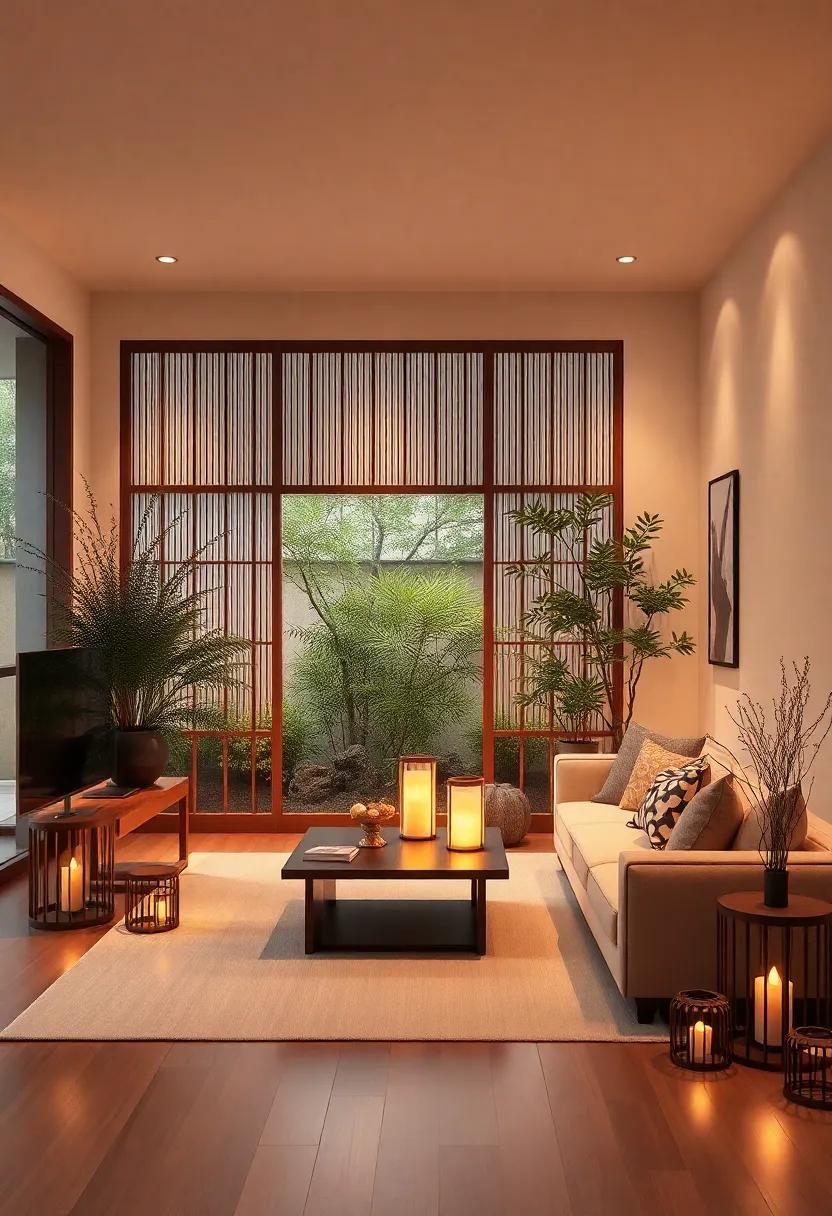
incorporating lanterns and soft lights into your living space creates a soothing atmosphere that resonates with the tranquility of a Japanese garden. The gentle flicker of lanterns exudes warmth, inviting you to unwind and connect with nature. Position these lights strategically around your living room to enhance the aesthetic appeal and encourage a sense of harmony. Consider using a mix of traditional paper lanterns and contemporary LED options to create layers of light that work beautifully together.You can also utilize dimmers to adjust the brightness based on your mood, filling the room with a soft glow as twilight descends.
To enhance this serene ambiance, you might explore different types of lighting fixtures that complement the overall theme of your design.Here are a few ideas to inspire your selection:
- Hanging Lanterns: Ideal for high ceilings, they draw the eye upward while providing even illumination.
- Tabletop Candle Holders: These can serve as focal points on coffee tables or shelves, casting a lovely flicker.
- Floor Lamps with Soft Shades: Offering a more modern touch, they can add height and softness to your seating area.
By balancing these light sources, you capture the essence of a serene garden setting within your living room. This blend of lighting not only elevates the aesthetic but also nurtures a calming retreat for family and guests alike. To further explore the beauty of lantern lighting, visit Japanese Gardening for inspiration and tips.
Symbolic objects: Incorporating Statues and Ornaments for meaning
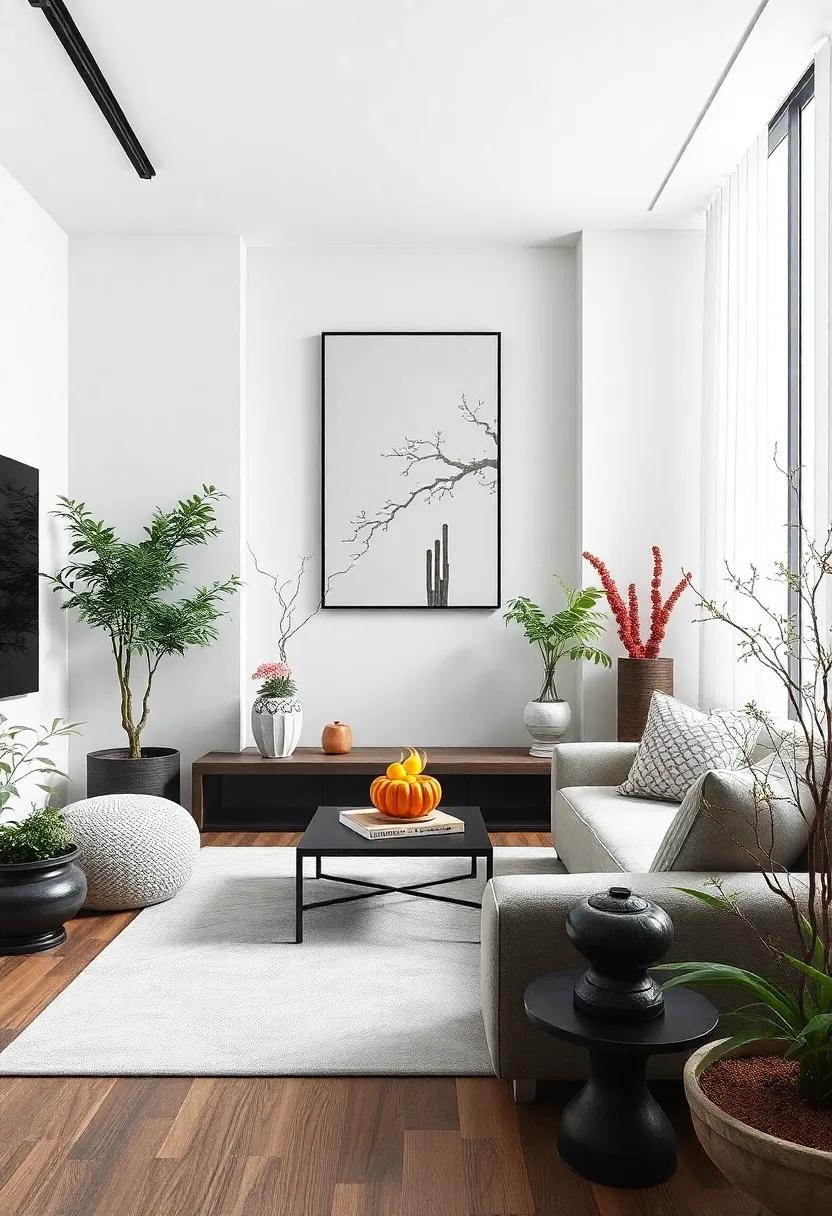
Incorporating symbolic objects such as statues and ornaments into your living room can considerably elevate the tranquility of your space, embodying the essence of a Japanese garden. Stone lanterns can serve as a centerpiece, casting a soft, inviting glow while symbolizing illumination and hope. Additionally, water features, like mini fountains or stone cascades, not only provide soothing sounds but also represent purity and clarity.These elements evoke a sense of peace and harmony, perfect for creating a serene atmosphere in your home.
To add further meaning to your decor, consider incorporating ornamental planters adorned with Bonsai trees or ceramic sculptures reflecting nature, promoting mindfulness and balance in your living room. The careful placement of these items can create a natural flow in the design, inviting calmness into your daily routine. You can even curate a small table to display these symbolic objects, ensuring they bring tranquility and beauty together. Here’s a simple table for selecting your symbolic objects:
| Object | symbolism | Placement Tips |
|---|---|---|
| stone Lantern | Illumination & Hope | Center or corner of the room |
| bonsai Tree | Mindfulness & Balance | coffee table or shelf |
| Mini Fountain | Purity & Clarity | Near seating area to hear the sounds |
By thoughtfully integrating these symbolic objects into your living room design, you create a personal sanctuary that reflects the peace and tranquility found in traditional japanese gardens. For more inspiration on garden designs and interior harmony, visit japanesegardens.com.
Textures of Japan: Layering Fabrics and Surfaces for Depth and Comfort
To evoke the serene beauty found in Japanese gardens, integrating various textures through carefully layered fabrics and surfaces is essential. Think of the soft touch of silk cushions juxtaposed against linen throw blankets, creating a cozy yet elegant atmosphere. Incorporating elements such as bamboo accents and natural wood finishes enhances the feel of authenticity while providing tactile contrasts that lure you into a tranquil space. Layer these textures in your living room by using a combination of:
- Woven rugs with earthy tones
- Canvas or cotton draperies for soft filtering of light
- Wooden furniture with rich, warm finishes
- Stone planters that introduce an organic feel
Crucially, the layering should not only be visual but also physical, encouraging a sense of comfort and relaxation. For instance, consider placing a plush area rug under low seating to ground the space, making it inviting. Adding elements like a textured wall feature, such as a faux-suiseki (Japanese stone), can infuse character while maintaining a minimalist approach. Tables and decor can further benefit from showcasing textures, as with:
| Material | Purpose | Example |
|---|---|---|
| Textiles | Softness and warmth | Shades of muted colors |
| Natural wood | Warmth and grounding | low wooden coffee tables |
| Stone | Stability and earthiness | Decorative pebbles in glass vases |
Ultimately, reveling in the combination of these elements can transport you to an oasis of tranquility reminiscent of japan’s serene landscapes. For more inspiration on Japanese design aesthetics, explore Architectural Digest.
Seasonal Changes: Adapting Your Space to Reflect the Four Seasons
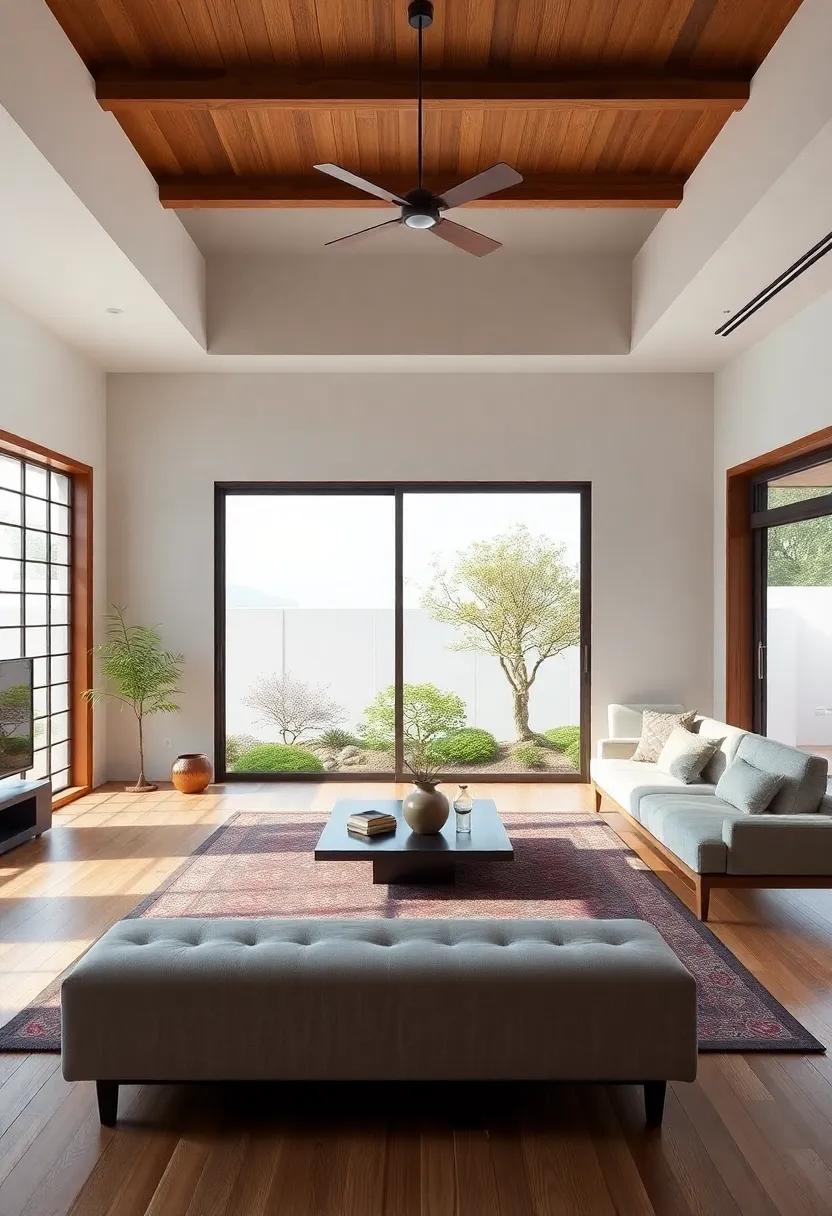
Transforming your living space to embrace the essence of each season can create an inviting atmosphere that resonates with nature’s beauty. Start by integrating seasonal decor that reflects the characteristics of the four seasons. For spring, consider adding vibrant cushions with floral patterns, while summer can be celebrated with light, airy textiles and fresh, natural scents.Autumn encourages the use of warm tones—like deep oranges and browns—through throw blankets and decorative pumpkins. winter can be harmoniously captured with rich textures, inviting greens, and minimalist lighting for a serene ambiance.
Drawing inspiration from traditional japanese gardens, you can enhance this seasonal adaptation by incorporating elements that symbolize the changing times of the year. Create miniature displays of seasonal plants, such as cherry blossoms for spring and evergreens for winter, which can be artistically arranged in decorative pots around the room. Use natural materials, like bamboo or stone, to construct small tables or shelves that echo a garden’s calm. Additionally, placing a simple water feature or a Zen sand garden on a coffee table can serve as a mindful focal point, offering tranquility while seamlessly blending with seasonal themes. For more insights on creating serene living spaces,visit japanesegarden.com.
Quiet Corners: Creating Intimate Nooks for Reflection and Relaxation
Create secluded spots that invite tranquility and introspection by incorporating elements often found in Japanese gardens. Begin by selecting low, cozy seating that encourages relaxation, such as floor cushions or small tatami mats, which evoke a sense of groundedness. Surround these areas with gentle lighting—think paper lanterns or LED strip lights—to mimic the serene glow of a moonlit evening. Additionally, you can enhance the ambiance with natural materials like bamboo or stone to create a tactile experience that connects you to the outdoors. A carefully placed indoor water feature, whether it’s a small fountain or a decorative bowl, can replicate the soothing sounds of nature, fostering a peaceful environment perfect for reflection.
Incorporate plants that resonate with the essence of a Japanese garden into your living room nook to deepen the peaceful atmosphere. Choose varieties such as bonsai or snake plants that can thrive indoors yet still provide a touch of greenery reminiscent of traditional gardens. You might also want to consider adding a small Zen sand garden as your centerpiece—just a shallow tray filled with sand and miniature rocks can serve as a meditative tool and also an artistic statement. By arranging elements in a thoughtful, minimalist fashion, create a cohesive and calming space that invites you to retreat from the busyness of everyday life. For more inspiration, visit japanesegarden.com for ideas on integrating these serene elements into your design.
Mindful Presence: Encouraging a meditative Atmosphere through Design

Incorporating elements reminiscent of a Japanese garden into your living room can evoke a sense of calm and tranquility. What initially captivates the eye in a Japanese garden is its harmonious arrangement that invites contemplation. To achieve this meditative ambiance, consider key features such as natural materials, earthy colors, and organic shapes. Transform your space by adding elements like shoji screens for separation, soft tatami mats for flooring, and handcrafted wooden furniture. The gentle play of light through sheer textiles can emulate the dappled sunlight seen in serene gardens, further enhancing the peaceful atmosphere.
For optimal results, focus on creating a balanced composition by integrating elements of nature.This can include:
- Indoor plants: Select greenery such as bonsai or bamboo that resonate with the garden aesthetic.
- Water features: A small tabletop fountain can introduce the soothing sound of flowing water.
- Stone accents: Incorporate rocks or gravel in decorative bowls to mimic zen garden landscapes.
When arranging these components, aim for simplicity and intentionality, allowing each item to have its own space to breathe. This curated approach not only brings the outside in but also fosters a mindful presence within your home. by thoughtfully designing your living room to reflect a piece of the Japanese garden, you invite serenity into your daily life. For more inspiration on creating tranquil spaces, visit japanesegardens.com.
inviting Nature Inside: Opening Up Spaces with Large Windows and Views
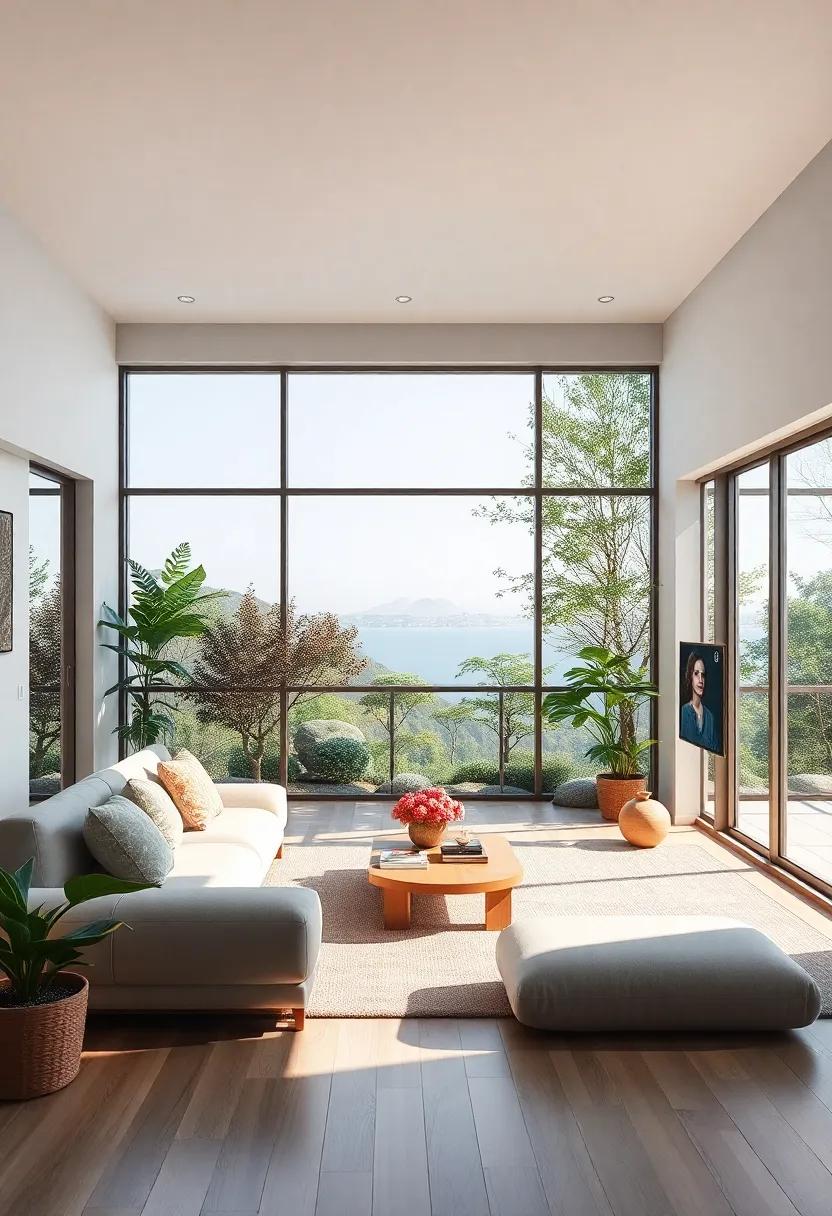
Imagine waking up each day to a breathtaking scene framed by expansive windows that invite the natural world into your living space. Large windows not only flood your room with light but also act as a canvas for the beauty of your surroundings. Positioning your furniture in a way that takes advantage of these views enhances the tranquility of your environment, allowing the calming presence of nature to seep into your daily life. Consider arranging your seating to face greenery or a calming water feature, creating a serene focal point that draws you into relaxation.
To fully embrace this harmony with nature, essential design elements can further enhance the interplay between your indoors and the outside world. Incorporate natural materials such as bamboo or stone, which resonate with the ethos of Japanese gardens. Soft textiles in muted tones can create a soothing atmosphere while enhancing comfort. Moreover, adding indoor plants not only purifies the air but also brings a touch of the garden inside. A few thoughtfully placed containers or a vertical garden can bridge the gap between the tranquil outdoors and peaceful interiors. For inspiration on integrating natural elements, visit Houzz for design ideas that can elevate your living room to a sanctuary of peace.
Cultural Touches: Infusing Authentic Japanese Aesthetics into Your Style
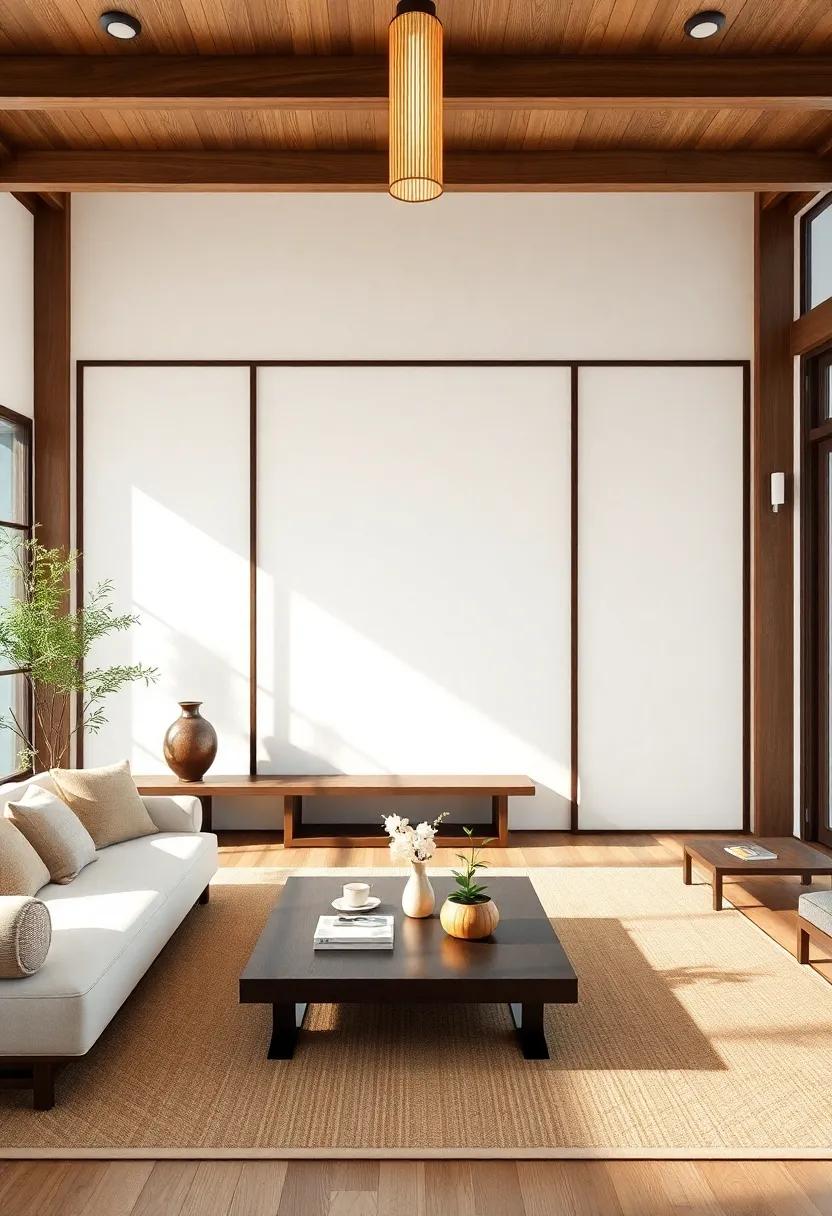
To achieve a tranquil atmosphere reminiscent of a Japanese garden, consider integrating natural materials and earthy tones into your living room design. Bamboo, stone, and wood are essential elements that can beautifully echo the serenity of a traditional garden. Utilizing low-profile furniture can enhance the sense of openness, while tatami mats or organic rugs can provide warmth underfoot. It’s also worth incorporating houseplants that mimic the lush greenery found in Japanese landscapes, such as bonsai, ferns, or snake plants, which can serve as living art pieces within your space.
Your choice of decor should reflect simplicity and harmony. Opt for minimalist pieces that promote calmness and avoid clutter. Some ideas include:
- Shoji screens to partition spaces or provide natural light
- Water features, like small fountains, to introduce a calming auditory element
- Japanese art and calligraphy that embodies nature or reflects Zen principles
- Stone lanterns or sculpture for a touch of authenticity
In blending these elements, your living room can transform into a serene retreat, where every item tells a story, mirroring the elegance of traditional Japanese gardens. For more inspiration on Japanese aesthetics, visit Japan Travel.
In Conclusion
As we close the chapter on our exploration of integrating Japanese garden elements into your living room design, it becomes clear that serenity is not merely a concept; it’s an experience to be cultivated. By blending natural materials, harmonious colors, and thoughtful arrangements, your living space can transform into a sanctuary where tranquility reigns. Every stone, every plant, and every arrangement tells a story—a narrative of calm and balance that resounds in the daily rhythm of life.
incorporating these elements allows you to escape the chaos of the outside world, creating a haven of peace right in the heart of your home. Whether it’s through the gentle presence of a bonsai or the soothing sound of a small water feature, each design choice invites a moment of pause and reflection. So take a deep breath, envision your space anew, and let the elegance of a Japanese garden inspire a refreshing perspective in your living room.
In this journey to embrace serenity, the ultimate goal is not perfection, but a space that resonates with your spirit and nurtures your well-being. As you step forward,may your efforts blossom into an oasis of peace,reminding you that in every corner lies the opportunity to cultivate calm,no matter the chaos beyond your walls.
